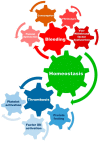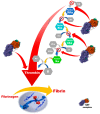Anticoagulation Strategies during Extracorporeal Membrane Oxygenation: A Narrative Review
- PMID: 36079084
- PMCID: PMC9457503
- DOI: 10.3390/jcm11175147
Anticoagulation Strategies during Extracorporeal Membrane Oxygenation: A Narrative Review
Abstract
The development of extracorporeal life support technology has added a new dimension to the care of critically ill patients who fail conventional treatment options. Extracorporeal membrane oxygenation (ECMO)-specialized temporary life support for patients with severe cardiac or pulmonary failure-plays a role in bridging the time for organ recovery, transplant, or permanent assistance. The overall patient outcome is dependent on the underlying disease, comorbidities, patient reaction to critical illness, and potential adverse events during ECMO. Moreover, the contact of the blood with the large artificial surface of an extracorporeal system circuit triggers complex inflammatory and coagulation responses. These processes may further lead to endothelial injury and disrupted microcirculation with consequent end-organ dysfunction and the development of adverse events like thromboembolism. Therefore, systemic anticoagulation is considered crucial to alleviate the risk of thrombosis and failure of ECMO circuit components. The gold standard and most used anticoagulant during extracorporeal life support is unfractionated heparin, with all its benefits and disadvantages. However, therapeutic anticoagulation of a critically ill patient carries the risk of clinically relevant bleeding with the potential for permanent injury or death. Similarly, thrombotic events may occur. Therefore, different anticoagulation strategies are employed, while the monitoring and the balance of procoagulant and anticoagulatory factors is of immense importance. This narrative review summarizes the most recent considerations on anticoagulation during ECMO support, with a special focus on anticoagulation monitoring and future directions.
Keywords: ECMO; adverse events; anticoagulation; complications; extracorporeal life support; future directions; inflammation; monitoring; mortality.
Conflict of interest statement
The authors declare no conflict of interest.
Figures



Similar articles
-
Anticoagulation Monitoring During Extracorporeal Membrane Oxygenation: A Narrative Review.J Cardiothorac Vasc Anesth. 2025 Sep;39(9):2446-2459. doi: 10.1053/j.jvca.2025.05.040. Epub 2025 May 24. J Cardiothorac Vasc Anesth. 2025. PMID: 40544097 Review.
-
Anticoagulation during extracorporeal membrane oxygenation: A narrative review.Perfusion. 2025 Apr;40(3):547-556. doi: 10.1177/02676591241250288. Epub 2024 Apr 26. Perfusion. 2025. PMID: 38671589 Review.
-
Venovenous Extracorporeal Membrane Oxygenation With Prophylactic Subcutaneous Anticoagulation Only: An Observational Study in More Than 60 Patients.Artif Organs. 2017 Feb;41(2):186-192. doi: 10.1111/aor.12737. Epub 2016 Jun 3. Artif Organs. 2017. PMID: 27256966
-
Management of Anticoagulation during Extracorporeal Membrane Oxygenation in Children.Pediatr Rep. 2022 Jul 11;14(3):320-332. doi: 10.3390/pediatric14030039. Pediatr Rep. 2022. PMID: 35894028 Free PMC article. Review.
-
Extracorporeal lung support technologies - bridge to recovery and bridge to lung transplantation in adult patients: an evidence-based analysis.Ont Health Technol Assess Ser. 2010;10(5):1-47. Epub 2010 Apr 1. Ont Health Technol Assess Ser. 2010. PMID: 23074408 Free PMC article.
Cited by
-
ECMO in Cardiogenic Shock: Time Course of Blood Biomarkers and Associated Mortality.Diagnostics (Basel). 2022 Nov 26;12(12):2963. doi: 10.3390/diagnostics12122963. Diagnostics (Basel). 2022. PMID: 36552970 Free PMC article.
-
Thrombotic Events Develop in 1 Out of 5 Patients Receiving ECMO Support: An 11-Year Referral Centre Experience.J Clin Med. 2023 Jan 30;12(3):1082. doi: 10.3390/jcm12031082. J Clin Med. 2023. PMID: 36769730 Free PMC article.
-
Pleiotropic Effects of Heparin and its Monitoring in the Clinical Practice.Semin Thromb Hemost. 2024 Nov;50(8):1153-1162. doi: 10.1055/s-0044-1786990. Epub 2024 May 29. Semin Thromb Hemost. 2024. PMID: 38810964 Free PMC article. Review.
-
Thromboelastography versus thromboelastometry for unfractionated heparin monitoring in adult patients on extracorporeal membrane oxygenation.Perfusion. 2025 Jan;40(1):235-242. doi: 10.1177/02676591241232513. Epub 2024 Feb 20. Perfusion. 2025. PMID: 38379295 Free PMC article.
-
Vascular Complications in Extracorporeal Membrane Oxygenation-A Narrative Review.J Clin Med. 2024 Aug 31;13(17):5170. doi: 10.3390/jcm13175170. J Clin Med. 2024. PMID: 39274383 Free PMC article. Review.
References
-
- Schechter M.A., Ganapathi A.M., Englum B.R., Speicher P.J., Daneshmand M.A., Davis R.D., Hartwig M.G. Spontaneously Breathing Extracorporeal Membrane Oxygenation Support Provides the Optimal Bridge to Lung Transplantation. Transplantation. 2016;100:2699–2704. doi: 10.1097/TP.0000000000001047. - DOI - PMC - PubMed
Publication types
LinkOut - more resources
Full Text Sources

